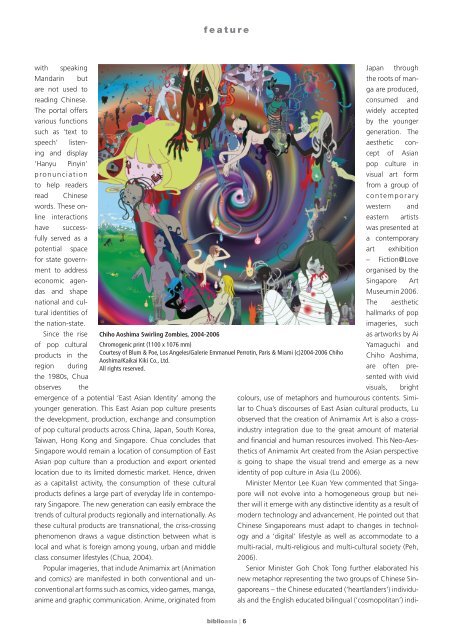Part I - National Library Singapore
Part I - National Library Singapore
Part I - National Library Singapore
Create successful ePaper yourself
Turn your PDF publications into a flip-book with our unique Google optimized e-Paper software.
f e a t u r e<br />
with speaking<br />
Japan through<br />
Mandarin but<br />
the roots of manga<br />
are not used to<br />
are produced,<br />
reading Chinese.<br />
consumed and<br />
The portal offers<br />
various functions<br />
such as ‘text to<br />
widely accepted<br />
by the younger<br />
generation. The<br />
speech’ listening<br />
aesthetic con-<br />
and display<br />
cept of Asian<br />
‘Hanyu Pinyin’<br />
pop culture in<br />
pronunciation<br />
to help readers<br />
visual art form<br />
from a group of<br />
read Chinese<br />
contemporary<br />
words. These online<br />
interactions<br />
western<br />
eastern<br />
and<br />
artists<br />
have successfully<br />
was presented at<br />
served as a<br />
a contemporary<br />
potential space<br />
art exhibition<br />
for state government<br />
– Fiction@Love<br />
to address<br />
organised by the<br />
economic agendas<br />
<strong>Singapore</strong> Art<br />
and shape<br />
Museum in 2006.<br />
national and cultural<br />
The aesthetic<br />
identities of<br />
the nation-state.<br />
Since the rise<br />
of pop cultural<br />
Chiho Aoshima Swirling Zombies, 2004-2006<br />
Chromogenic print (1100 x 1076 mm)<br />
hallmarks of pop<br />
imageries, such<br />
as artworks by Ai<br />
Yamaguchi and<br />
products in the<br />
Courtesy of Blum & Poe, Los Angeles/Galerie Emmanuel Perrotin, Paris & Miami (c)2004-2006 Chiho<br />
Chiho Aoshima,<br />
Aoshima/Kaikai Kiki Co., Ltd.<br />
region during All rights reserved.<br />
are often presented<br />
the 1980s, Chua<br />
with vivid<br />
observes the<br />
visuals, bright<br />
emergence of a potential ‘East Asian Identity’ among the<br />
younger generation. This East Asian pop culture presents<br />
the development, production, exchange and consumption<br />
of pop cultural products across China, Japan, South Korea,<br />
Taiwan, Hong Kong and <strong>Singapore</strong>. Chua concludes that<br />
<strong>Singapore</strong> would remain a location of consumption of East<br />
Asian pop culture than a production and export oriented<br />
location due to its limited domestic market. Hence, driven<br />
as a capitalist activity, the consumption of these cultural<br />
products defines a large part of everyday life in contemporary<br />
<strong>Singapore</strong>. The new generation can easily embrace the<br />
trends of cultural products regionally and internationally. As<br />
these cultural products are transnational, the criss-crossing<br />
phenomenon draws a vague distinction between what is<br />
local and what is foreign among young, urban and middle<br />
class consumer lifestyles (Chua, 2004).<br />
Popular imageries, that include Animamix art (Animation<br />
and comics) are manifested in both conventional and unconventional<br />
art forms such as comics, video games, manga,<br />
anime and graphic communication. Anime, originated from<br />
colours, use of metaphors and humourous contents. Similar<br />
to Chua’s discourses of East Asian cultural products, Lu<br />
observed that the creation of Animamix Art is also a crossindustry<br />
integration due to the great amount of material<br />
and financial and human resources involved. This Neo-Aesthetics<br />
of Animamix Art created from the Asian perspective<br />
is going to shape the visual trend and emerge as a new<br />
identity of pop culture in Asia (Lu 2006).<br />
Minister Mentor Lee Kuan Yew commented that <strong>Singapore</strong><br />
will not evolve into a homogeneous group but neither<br />
will it emerge with any distinctive identity as a result of<br />
modern technology and advancement. He pointed out that<br />
Chinese <strong>Singapore</strong>ans must adapt to changes in technology<br />
and a ‘digital’ lifestyle as well as accommodate to a<br />
multi-racial, multi-religious and multi-cultural society (Peh,<br />
2006).<br />
Senior Minister Goh Chok Tong further elaborated his<br />
new metaphor representing the two groups of Chinese <strong>Singapore</strong>ans<br />
– the Chinese educated (‘heartlanders’) individuals<br />
and the English educated bilingual (‘cosmopolitan’) indibiblioasia<br />
|

















